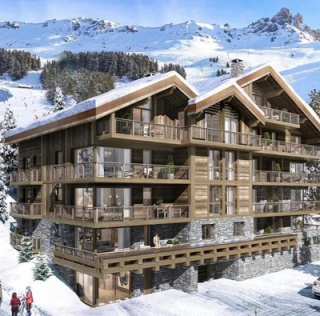Sotheby's International Realty
- 222 rue des Jeux Olympiques
- 73550 Les Allues, France
- +33 9 70 71 99 95
Sotheby's International Realty
- 93 rue Saint François de Sales
- 74120 Megève, France
- +33 4 50 91 74 38
Sotheby's International Realty
- Rue de l'Eglise
- 73120 Courchevel 1850, France
- +33 4 79 08 34 73
The DPE: an obligation for sales

The real estate DPE is a regulatory document that assesses the energy performance of a building. This measure is essential when selling or renting a property. It provides buyers and tenants with an objective estimate of the energy consumption of a home or commercial space. It also provides information on the greenhouse gas emissions resulting from the use of the said property.
What is the DPE?
The Energy Performance Diagnostic (DPE) is mandatory when selling or renting a property. It allows potential buyers or tenants to have a clear view of the energy performance of the home and to take this aspect into account in their purchase or rental decision. This energy diagnostic is valid for a period of 10 years.
Conducting the DPE by a certified inspector
The DPE is carried out by a duly certified real estate inspector, who conducts a thorough inspection of the property in question. During this assessment, the professional considers several key parameters such as thermal insulation, heating system, ventilation, and equipment related to hot water production. The data collected is then used to estimate the building's energy consumption.
Energy and climate labels of the DPE
The result of the DPE is presented in the form of two distinct labels: the energy label and the climate label. The energy label assigns a grade ranging from A to G to the property, where A represents high energy efficiency, while G indicates poor energy performance. The climate label follows a similar classification, assessing the greenhouse gas emissions associated with the use of the building.
Importance of the DPE in the energy transition
Beyond its regulatory aspect, the DPE is part of the context of energy transition and the fight against climate change. It is useful for raising awareness among owners and residents about the environmental impacts of their consumption. This tool also aims to provide recommendations for improving the energy performance of the home or premises. These recommendations can include insulation work, replacing the heating system with a more efficient solution, installing temperature regulation devices, or using renewable energy sources.
Steps to complete this diagnostic
Here are the different steps to successfully carry out the real estate DPE process:
Selecting a certified inspector
Choose an independent professional who has obtained the required certification to perform the DPE. This certification attests to compliance with current standards and regulations, ensuring the reliability and expertise of the professional.
Scheduling the inspector's visit
Plan a visit of the property to be diagnosed. Ensure access to all areas, including attics, basements, heating, and hot water production equipment. Also, prepare necessary information such as construction plans, previous energy bills, and other relevant documents.
Data collection
During the visit, the real estate inspector collects information related to the building. This includes construction characteristics, materials used, heating and cooling systems, ventilation, insulation, windows, etc. The inspector may use specialized measuring instruments to obtain precise data.
Analysis and calculations
À partir des données collectées, le diagnostiqueur réalise une analyse approfondie conformément à la méthode de calcul réglementaire en vigueur. Ces mesures intègrent des paramètres spécifiques du bâtiment, tels que la surface, l'orientation, l'efficacité des systèmes énergétiques, pour évaluer la consommation énergétique et les émissions de gaz à effet de serre.
Writing the DPE report
The inspector writes a detailed and comprehensive DPE report. This document presents the obtained results, including the energy and climate labels, as well as specific recommendations aimed at improving the building's energy performance. Writing the report requires precision, clarity, and adherence to current legal requirements.
Delivering the report and validity
Finally, the inspector gives you the real estate energy diagnostic. Keep the document carefully to present it during any subsequent real estate transaction, whether it is a sale or a rental. The DPE is valid for 10 years, after which a new evaluation is necessary.
Exemptions from the DPE
There are exemptions from the mandatory DPE. These are specific regulatory exceptions, the most common of which are:
New buildings
New constructions generally benefit from a DPE exemption, as they are subject to stricter regulations ensuring minimal energy performance. However, some specific operations, such as the sale of a new home within the first five years after its construction, may require a DPE.
Non-residential low-energy buildings
Agricultural, industrial, or craft buildings, whose energy consumption is below a determined threshold, may be exempt from the DPE requirement.
Small independent buildings
Small independent structures with an area of less than 50 m² can also be exempt from the DPE if their surface area is below a defined value. The same applies to properties not equipped with a fixed heating system. This exemption aims to lighten administrative obligations for smaller buildings.
Buildings destined for demolition
Buildings slated for imminent demolition may be exempt from the DPE requirement, as this assessment would be superfluous due to the non-permanence of the structure. However, this exemption does not relieve the owner from the obligation to inform future buyers or tenants about the property's precarious condition. This also includes temporary constructions planned for use for less than two years, such as modular buildings, exhibition pavilions, or model homes.
Historic monuments
The Energy Performance Diagnostic (DPE) is a legal requirement when selling or renting real estate, allowing for a precise evaluation of energy performance with energy and climate labels. Conducted by a certified inspector, it raises awareness about the energy transition and provides specific recommendations to improve the energy efficiency of buildings. Exemptions may apply to certain types of constructions, but the real estate DPE remains an essential tool in the sustainable management of real estate assets.
→ Contact our agency, real estate specialist in Méribel







